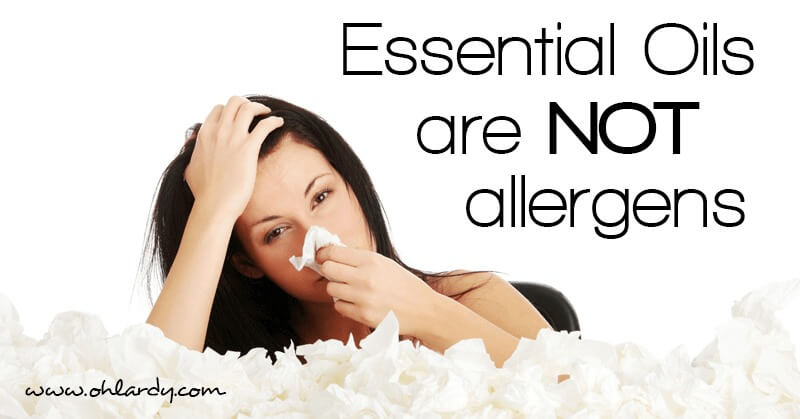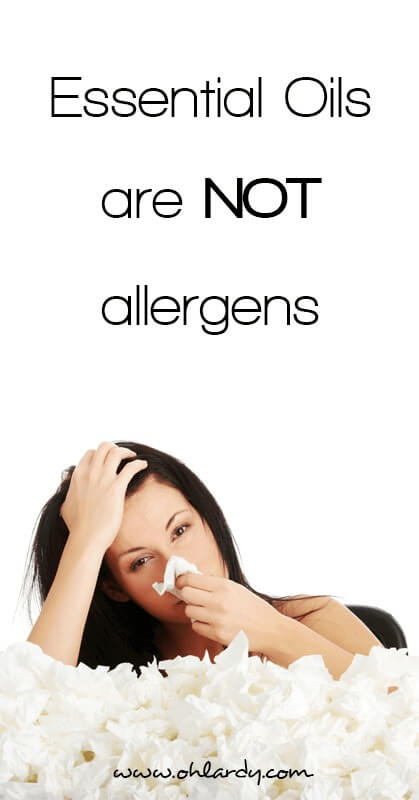Essential Oils are NOT Allergens
Oh Lardy! is a participant in the Amazon Services LLC Associates Program, an affiliate advertising program designed to provide a means for us to earn fees by linking to Amazon.com and affiliated sites.

By Dr. David Stewart
1) Allergens are almost always composed of proteins or polypeptides, which are relatively large molecules. There are no proteins or polypeptides in essential oils. In fact, nitrogen containing compounds are virtually non-existent in essential oils except in occasional trace amounts.
2) Allergens are composed of large molecules. There are no large molecules in volatile or aromatic oils, otherwise they would be neither volatile or aromatic.
3) There has never been a documented instance of an anti-body response (i.e. sensitization) to an essential oil.
Essential oil antibodies have never been found or detected in anyone. Unless sensitization occurs and antibodies are produced and stored in the body, there can be no allergic reaction. Therefore, we can state unequivocally that essential oils are not and cannot be allergens. Sometimes people do have allergy-like reactions but these are no allergenic in nature. They are detox reactions.
While allergenic reactions from pure therapeutic grade essential oils never happen, this might not be true for perfume, massage, or food grade oils, depending on what synthetic substances and fatty oils are used to alter and dilute them. However, even in cases of reactions to non-therapeutic grade oils, reactions are not likely to be allergens.
To be an allergic reaction, there must be antibodies in the system of the person having the reaction. There must be a period of prior sensitization before an allergic reaction can occur. If a person has a reaction to an essential oil the first time they receive it, it cannot be an allergy, because there was no prior exposure whereby sensitization and development of antibodies could have taken place. Such a reaction is nonallergenic.
People can be allergic/sensitive to fatty oils. This is because fatty oils are not distilled. They are cold pressed from the fruit and seed and contain many molecules that would not survive distillation but do come through a pressing. Among these molecules are traces of proteins, amino acids, and polypeptides – all potential allergens.
For massage purposes, essential oils are often added to fatty oils. When this is done, the possibility of an allergic reaction exists. Fatty oils are implicated as potential allergens include walnut, almond, olive, peanut, safflower, and virtually any vegetable oil.
Allergic reactions are also possible to expressed oils (citrus) and aromatic oils obtained by solvents (such as jasmine, onycha, or neroli). These two types of oils are not true essential oils since they are not obtained by distillation. Distilled oils are never allergens. Absolutes, expressed oils, and fatty oils can be allergens, including carrier oils. According to data reported in A Statistical Validation of the Raindrop Technique, the most frequently reported negative results of applying undiluted oils was a burning sensation on the skin, skin rashes, nausea, headaches, and tiredness (in that order).
Among the outcomes of thousands of Raindrops sessions included in the report, no negative experiences more severe than these were reported. Not one case of an allergic reaction was discovered by this study even though an honest effort was made to find and report such reactions if they existed. In all the reports of negative outcomes with undiluted oils in the study, experiences were temporary and interpreted as detox reactions, not allergies.
Given enough time, accompanied by a cleansing regimen, detox reactions to oils will cease and the oils that caused the reaction initially will no longer do so. This is an indication that the cleansing is complete and proof that the reactions was no allergy. When a detox reaction happens, stop using the oils for awhile and reduce their quantity in order to slow down the release of toxins. Focus on cleansing procedures with lots of water, fiber, and fresh foods and, perhaps, some fasting, to flush out the toxins.
Gradually, use the oils again and eventually the toxins will be gone and you won't have unpleasant reactions to the oils any more. Many people have experienced this. Detox reactions may be unpleasant but they are temporary and beneficial. They are the beginning of healing in a body full of toxins that would have eventually resulted in a serious chronic disease.
Source: The Chemistry of Essential Oils Made Simple – God's Love Manifest in Molecules” by David Stewart, Ph.D, D.N.M.
Pin it!
Young Living sets the standard for pure oils.


What a great article! Perfect timing too, my Dad and I were just talking about this. I will have to share it with him, maybe it will bring him over to the “oily” side! Thanks!
So this DOES mean that not all Young Living oil blends are non-allergenic. I think this article should really stress that – the carry-away from this article implies that Young Living oils are non-allergenic, and that is not true for all of them.
While the article does say, “For massage purposes, essential oils are often added to fatty oils. When this is done, the possibility of an allergic reaction exists. Fatty oils are implicated as potential allergens include walnut, almond, olive, peanut, safflower, and virtually any vegetable oil” it doesn’t make clear that many of the Young Living blends are in this category.
Acceptance, Awaken, Hope, Into The Future, Present Time, Sara, 3 Wise Men, and White Angelica are all in almond oil; Aroma Life, EndoFlex, Forgiveness, Humility, JuvaFlex, Mister, are in sesame oil (HUGE allergen here); Exodus II and Release are in olive oil; Valor is in coconut oil, and Oola Grow contains both olive and almond oils.
Hopefully consumers are reading labels, I just worry when I see the implication that all of Young Living’s oils are safe for those with allergies.
I came down with a terrible rash. Three weeks in, I finally went to the dr. Only thing different that I had been doing was using frankensence, diluted in coconut oil, on my fence. The rash was so bad I ended up taking prednisone to help clear it up. I had been “cleared” up for three days when I used the doterra blend, Balance, on the back of my neck. I used it three days in a row and suddenly my rash is back. Horribly uncomfortable. So. Is this article saying I’m not allergic to frankensence? How do I detox so I can use this oil? The oils I use are doterra oils.
When I was at Winter Harvest in Idaho, Gary Young mentioned that a presentation of a rash may indicate an allergy to phenols and a deficiency in sulphur. He mentioned doing a detox and avoiding EOs for 3 to 6 months. Also, I can not vouch for the quality of DoTerra oils.
Besides having your sulphur levels checked and doing a detox, perhaps try Young Living’s Frankincense to see if you get the same reaction.